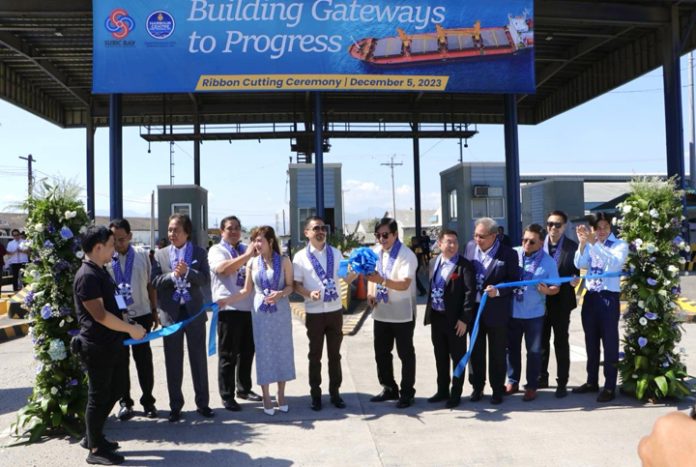
-
Subic Bay Metropolitan Authority and Harbour Centre Port Terminal Inc. finalized a P5.5B joint venture and inaugurated the terminal operation at Naval Supply Depot
-
Operating the NSD and developing Subic areas are part of the 2010 JV agreement signed between the two entities
-
Some stakeholders have raised concerns over the JV implementation, citing potential cargo-handling monopoly in Subic Bay Freeport Zone
The P5.5 billion-joint venture (JV) agreement between the Subic Bay Metropolitan Authority (SBMA) and Harbour Centre Port Terminal Inc. (HCPTI) has been realized with an inauguration of terminal operations at the Naval Supply Depot (NSD) in Subic Bay Freeport Zone.
The JV agreement was signed in 2010 and calls for the operation of the NSD for 25 years, with plans to develop other areas in Subic, including the ports/wharves of Boton, Alava, Rivera, and Bravo.
SBMA chairman and administrator Jonathan D. Tan, in a statement, said he expects the 10-year JV with HCPTI to spur growth in the port businesses inside the Freeport.
“Our goal at SBMA is in line with HCPTI’s goal of creating more employment opportunities, generating new income, boosting tourism, attracting more foreign and local investments, and expanding the trading business in Subic,” Tan said during the inauguration on December 5.
He added that the upgrade of port facilities are expected to improve cargo processing efficiency, reduce ship turnaround times, and increase the handling of bulk and break bulk cargoes.
HCPTI chairman Reghis Romero II said that with the inauguration of the Subic Port operation, the country will be able to provide enough buffer from global inflation and regional conflicts.
“Thanks to the fact that our economy is driven by consumption such that the nation can consume what it can produce. To a large extent, it makes our economy virtually self-sustaining. But to ensure economic expansion amid the growing domestic requirements, we have to trade beyond our borders and attract foreign capital and technologies,” Romero said.
It must be noted that the implementation of the JV has faced delays due to stakeholders’ various concerns about the project.
The Philippine Ship Agents Association (PSAA) for one has raised concerns about potential monopolization of cargo-handling services in the Subic Bay Freeport Zone.
PSAA argues this monopoly could harm consumers, hinder innovation, contradict Philippine competition laws, and impede the growth of the maritime industry.
READ: PSAA opposes cargo-handling ‘monopoly’ in Subic Bay
In addition, SBMA port operators—Amerasia International Terminal Services, Mega Subic Terminal Services, and Subic Seaport Terminal Services—have sought clarification on the management takeover by HCPTI.
The impending monopoly feared by stakeholders is an offshoot of a Supreme Court (SC) Third Division ruling in December 2021 that reversed Court of Appeals decisions in 2013 and 2014, and reinstated a 2012 Olongapo City Regional Trial Court (RTC) ruling in favor of HCPTI.
The Olongapo RTC had ordered SBMA to issue the Notice of Award (NOA) and Notice to Proceed (NTP) for the JV agreement between HCPTI and SBMA.
Over the years, the case has had many twist and turns.
After the HCPTI-SBMA JV agreement was signed, the National Economic and Development Authority (NEDA) in 2011 withdrew its endorsement of the project based on alleged violation of the 2008 Guidelines and Procedures for entering into JV agreements between government and private entities issued by the agency.
The SBMA sought a reconsideration but its Board, in a resolution, deferred action on the award of the project to HCPTI pending NEDA’s response.
During the pendency of the RTC proceedings, NEDA denied SBMA’s request for reconsideration, reiterating its withdrawal on September 30, 2011.
HCPTI filed a petition for mandamus before the Olongapo RTC due to SBMA’s failure and refusal to issue the NOA and NTP.
The Office of the Government Corporate Counsel, which initially found the agreement valid, recommended suspending issuance of the NOA due to NEDA’s withdrawal of its endorsement and pending further study of the JV agreement.
The CA in 2013 reversed the 2012 Olongapo RTC decision favoring HCPTI, and held that SBMA has no legal duty to issue the NOA and NTP because “the SBMA has the discretion to either approve or reject the recommendation to award” and that HCPTI “has no vested right to the issuance of the NOA and the NTP.”
HCPTI moved for reconsideration but this was denied by the CA in 2014.
“In sum, there is no law justifying the non-issuance of the NOA due to the withdrawal of the NEDA (National Economic and Development Authority) endorsement. Petitioner (HCPTI) has complied with all the legal requisites for the issuance of the NOA. As such, a writ of mandamus may issue to compel SBMA to perform its legal duty,” the SC, in a decision penned by Associate Justice Rodil Zalameda and only made public last May 18, 2023, said.
“It appears that there is no legal or contractual obstacle to the issuance of the NTP. Hence, the same must also be issued to petitioner in preparation for the implementation of the JVA (joint venture agreement), and so that the parties may start complying with other conditions precedent stipulated therein,” the high court added.




